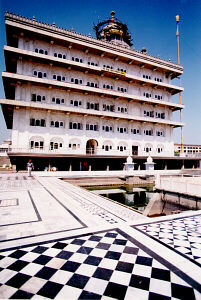Historical Gurdwaras of Punjab - Guru Arjan
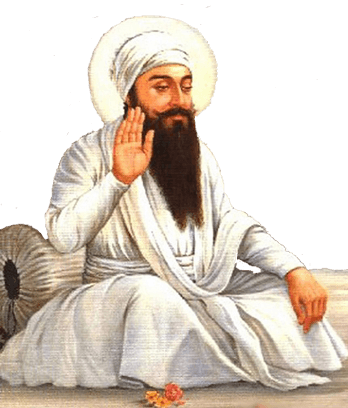
Birth of a Guru
Gurdwara Chaubara Sahib, Goindwal, Dist. Amritsar
Guru Arjan was born here in 1563. This was the family home of Guru Amar Das who founded the town of Goindwal and settled down here upon becoming Guru on the advice of Guru Amar Das. In this same house Guru Ram Das was installed as Guru in 1574. Guru Amar Das left this world here in 1574 and Guru Ram Das left this world here in 1581.
.jpg)
Marriage and Installation as Guru
Gurdwara Guru Ka Mahl, Dist. Amritsar
It was in the house here that Guru Arjan was married. Guru Arjan was also installed as Guru here in 1581. This was the home of Guru Ram Das and his family. Guru Ram Das founded the city of Ramdaspur (modern day Amritsar) and started the excavation of the 'pool of nectar' called Amritsar. Guru Hargobind lived here for some time and was also married here. This is also the birthplace of Guru Hargobind's sons Baba Atal Rai and Guru Tegh Bahadur.
.jpg)
The Spiritual Heart
Darbar Sahib (The Golden Temple), Dist. Amritsar
The Harmandir Sahib (meaning Temple of God) is also commonly known as the Golden Temple or Darbar Sahib (Divine Court). Darbar Sahib is a living symbol of the spiritual and historical traditions of the Sikhs. It is a source of inspiration for all Sikhs. The temple with it's glistening gold covered exterior stands in the middle of the tank of nectar. The Darbar Sahib has entrances and doors on all four sides. Guru Arjan exclaimed; "My faith is for the people of all castes and all creeds from whichever direction they come and to whichever direction they bow." Guru Amar Das asked Ram Das to build a central place of congregation for the Sikhs. Guru Ram Das started excavation work in 1577 during his lifetime. Guru Arjan completed excavation of the Tank known as Amritsar (The Pool of Nectar) in 1588. Guru Arjan then started construction of the Temple building itself which was finally completed in 1601. The first edition of the Holy Book of the Sikh's The Guru Granth Sahib was installed there in 1604 with Baba Buddha as the first granthi (caretaker of the book). The last Sikh Guru to live in Amritsar was Guru Hargobind. In 1664 Guru Tegh Bahadur visited Darbar Sahib but was refused entry by the corrupt temple caretakers, the Masands. Darbar Sahib has always been a rallying point for Sikhs throughout it's history. Around 1740 Massa Ranghar, the Muslim ruler of Amritsar desecrated the Temple by using it as a dancing hall. He was killed by the Sikh hero Mahtab Singh. In 1761 the Afghan Ahmed Shah Abdali blew up the Temple and filled in the Sacred Tank with refuse. The great Sikh martyr Baba Deep Singh laid down his life in revenge. The construction of the Darbar Sahib as it appears today was begun in 1764 when Jassa Singh Ahluwalia laid the foundation stone. Many of the doors, walls and domes were covered with copper sheets overlaid with gold during the reign of Maharaja Ranjit Singh. Darbar Sahib was partially damaged by the military invasion of the Indian Army during June 1984.
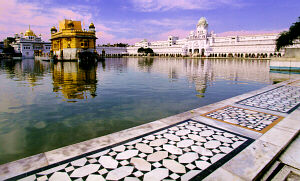
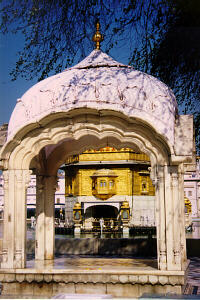
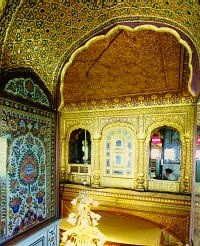
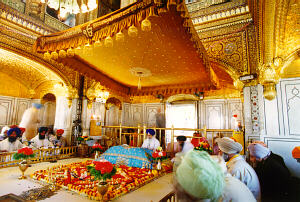
In Memory of Guru Ram Das
Gurdwara Sri Tarn Taran Sahib, Dist. Amritsar
Around 1590 Guru Arjan set out on a tour of the country between the rivers Ravi and Beas. Here Guru Arjan bought some land and laid the foundation of a Gurdwara in honor of Guru Ram Das and started the excavation of a tank even larger than Amritsar. The Gurdwara has one of the largest tanks and resembles the Golden Temple, except that it is built on the side of the tank and has a marble exterior. Guru Arjan also established the first home for lepers in India at Tarn Taran.
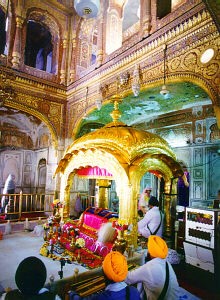
Start of a New Town
Gurdwara Tham Sahib, Kartarpur, Dist. Jalandhar
When visiting the Jalandhar area Guru Arjan purchased some land and founded the town of Kartharpur. A sandalwood post (Tham) stands in the Gurdwara, Guru Arjan had stuck it into the ground exclaiming "This shall be the support of our faith."
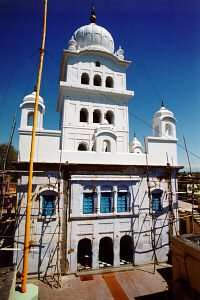
Visit to the House of Nanak
Gurdwara Bath Sahib, Dist. Gurdaspur
The ascetic son of Guru Nanak and the founder of the Udasi order Baba Sri Chand lived here deep in the forest for the last part of his life. Baba Sri Chand was visited here by Guru Arjan who told Baba Sri Chand about the hostility of the Gurus elder brother. Baba Sri Chand replied: "This will be his undoing and ruin both in this world and the next". Guru Hargobind also visited Baba Sri Chand here and when Baba Sri Chand complimented the Guru on his chivalry and piety, Guru Hargobind replied with great humility, "It is all the result of your blessing". Guru Hargobind also gave his son Baba Gurditta to Baba Sri Chand as the next leader of the Udasi order. Baba Sri Chand died and was cremated here in 1612 at the ripe old age of 118.

Blessings of a Saint
Gurdwara Bir Baba Buddha, Dist. Amritsar
Baba Buddha used to live here in the jungle outside Amritsar. Being without a child for many years Guru Arjans wife Ganga Devi became anxious. Guru Arjan told her; "If you wish a child, ask a pious Sikh like Baba Buddha, the aged seer and devout disciple of Guru Nanak for a blessing". Ganga Devi went to seek the blessings of Baba Buddha with a large entourage. She presented Baba Buddha with many delicacies to eat. Baba Buddha refused to provide any blessings. Upon hearing what happened, Guru Arjan told his wife to return this time on foot, with a simple meal prepared by herself. This time Baba Buddha was delighted and partook of the simple food. He prophesied; "A son will be born to you who will crush the enemies of Nanak's house, just as I have crushed this onion with my hand." That prophecy was to soon thereafter come true with the birth of Guru Hargobind in 1595.
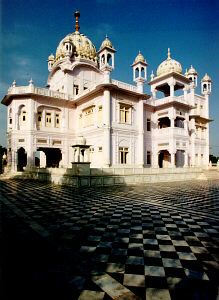
Completion of the Holy Granth Sahib
Gurdwara Ramsar, Dist. Amritsar
Guru Arjan spent a year here at the side of a pool with shady trees along with his scribe Bhai Gurdas and compiled the first copy of Sri Guru Granth Sahib in 1604. Guru Arjan not only included his own compositions but those of the previous four Gurus as well as the writings of Hindu and Muslim saints. There is no holy book like Sri Guru Granth Sahib, that includes the writings of people of other faiths, and which was written in the founding Gurus own writing. Upon completion the Sacred Volume was then installed in the Golden Temple by Guru Arjan with Baba Buddha appointed it’s first Granthi (caretaker).
